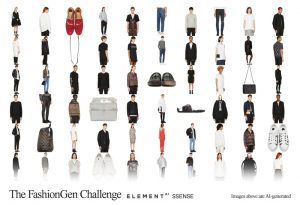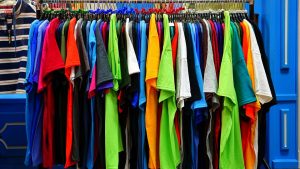Among the many promises of positive change connected to artificial intelligence, machine learning and big data analysis is the ability to help you decide what to wear today.
It’s not a pressing social issue, I know, but what to wear is a huge global business: worldwide revenue in the fashion and apparel industry is over $480 billion (USD) this year, with projections of over $700 billion by 2022.

These images were generated by AI (Image: CNW Group/Element AI)
That’s one reason why two leading Canadian companies, one from the fashion sector, one an artificial intelligence firm, are working together to push AI applications into the fashion industry.
Retail platform operator SSENSE and advanced tech company Element AI want to better understand how artificial intelligence can positively influence the future of fashion by analyzing fashion trends, building new scalable business models and creating the next clothing ensemble we just have to have.
“AI has the potential to power distinctive customer experiences across our online and physical touch points. A key pillar of the AI strategy at SSENSE is finding and interacting with the right set of partners such as Element AI,” Vincent Ho-Tin-Noe, Vice President of Product Management for SSENSE, described in a statement. “We are very excited to support fundamental AI research by opening a collection of labeled images consisting of the latest clothing, bags, shoes and accessories to the scientific community. We look forward to seeing the breakthroughs in AI research that this collection will enable.”
To trigger the next wave of techo-enabled fashion and support that fundamental research, the two companies (both are based in Montreal) have released a visual archive and image collection of literally hundreds of thousands of HD photos of clothes, objects and attractive models, shot by professionals in a studio environment. The images can be manipulated in 3-D space, and each image comes with comprehensive metadata that includes technical information as well as descriptive captions from experts.
Called FashionGen, the online e-commerce image collection is now open to registered researchers, academics and industry practitioners. What’s more, a $2,000 (CDN) prize is available to the project team that best makes use of the archive and corresponding dataset to develop new machine learning algorithms and AI training applications for the fashion industry.
Large visual databases like FashionGen and ImageNet are great for use in visual object recognition software research. With over 20 thousand image categories with several hundred images in each, such datasets can be great learning environments for advanced AI machines. Competitions to develop the best AI tools attract dozens of competing teams; last year, they developed programs that identify and classify visual elements in an image with only a five per cent error rate. This year, the competition wants to integrate 3-D objects into the challenge and bring down the error rate.

Artificial intelligence, machine learning and big data analysis is the ability to help you decide what to wear today – even if nothing matches. Creative Commons image.
Deep analysis of large image databases identifies the individual core elements that make up any image. It can determine which individual element is generating what positive reaction. Machines learn the hierarchy of visual features and fashion success. Is it the background that makes people respond? Is it the print or pattern, the colour or tone? What accessories are people talking about, and which are the fastest to market?
Fashion trend forecasting has been around a long time, but only recently has it been fuelled by the power of machine learning and big data. By collecting information about clothing and apparel sales from vendors, about human associations and personal inspirations from social media, and about product development and marketing penetration cycles from industry, forecasters say they can come up with actionable intelligence and valuable insights.
A New York-based company called WGSN is one of the largest and most mature players in the fashion forecasting and trend information business. It has its own image collection of more than 70,000 design templates, as well as a database of patterns and colours to which more than 6,000 paying subscribers (designers, retailers and the like) have access.
U.K.-based retail analytics firm Edited has used machine learning for several years now to identify fashion trends seen at runway shows by assessing which colours, textures, prints and silhouettes generate the most desired responses.
So skilled have techno-fashionistas become through the combination of AI, machine learning and data analysis that many observers say it is now a case of fashion dictating, not fashion forecasting, that technology has enabled.
As data scientists pour over their collected fashion information, fashion designers can in fact create new styles almost instantaneously; they can certainly change their ideas on the fly and get product to market more quickly using analyzed data about previous and current market activity.
Supported as by artificial intelligence and learned machines, the fashion world quickly adopting the concepts of generative design (in which clothes designers can input various clothing parameters like colour, material, weight, strength, manufacturing method, etc. into special software that explores all possible outcomes) and augmented creativity (in which machines follow their own creative muse by processing and collecting raw data. Machines then develop and build a prototype based on that data, and they evaluate and revise the concept in order to improve performance or identify alternatives. Finally, the machines deliver on their own idea).
“Fashion is in the midst of a technological revolution and machine learning is key to unlocking a new universe of possibilities,” said Element AI CEO Jean Francois Gagné. “New technologies are within reach and are now closer to reality thanks to the comprehensive collection of e-commerce images SSENSE is releasing and Element AI’s ability to layer our advanced computer vision and machine learning abilities over the data.”
Gagné added that the FashionGen image platform will debut in time for the European Conference on Computer Vision (ECCV), a biennial research conference on computer vision and machine learning which he called “the right conference to launch and see what’s possible” with AI, in machine learning and talented members of the community.
* * *
Now, not having seen the attendee list, there’s no way to be sure, but one could speculate that Chris Wylie may be in attendance.
While he is part of the fashion trend community, he is perhaps more well-known as the whistleblower in the Cambridge Analytica / Facebook / election hacking scandal.
Wiley, reports indicate, was actually studying for a PhD in fashion trend forecasting when he saw some interesting parallels between the use of big data to analyze, even create, fashion trends and the use of big data to analyze, even influence, voter habits.
It seems like a bit of a stretch at first, but the culture-changing power of fashion is in fact much like the product competition that many democratic elections have become. There’s a familiarity factor at play and lots of emotional responses in both arenas. With a clever mash-up of adept programmers, psychological profilers and muscular machines, well, telling us what vote to cast has much in common with telling us what shoes to buy.
(Wylie has said as much in his testimony about the potential power of database manipulation: comparing U.S. President Donald Trump with a pair of Crocs, he has described how technology can help move an initially unknown or disliked product to the top of the charts.)
See a product, service or candidate enough times, it becomes more and more viable. Say how good the product, service or candidate is enough times, it becomes more and more believable. Trend predicting becomes trend dictating with the power of artificial intelligence, machine learning and big data analysis.
-30-



